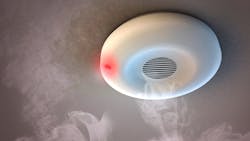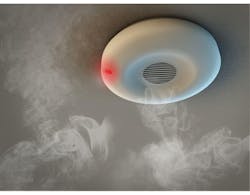Why Should You Use Long-Range Narrowband in a Smoke Detector?
This file type includes high resolution graphics and schematics when applicable.
This is the second installment in a blog series regarding practical applications involving narrowband technology (see “Why Did Europe Choose Narrowband for Long-Range Smart Gas Meters”).
Technology shifts are big business opportunities, especially when an existing application moves to a new, more advanced technology. This shift is now happening with TV remotes, which are moving from IR to RF, representing potentially huge growth for RF in remote controls.
Another lesser-known market opportunity is the fire-detection market. Most commercial and industrial buildings today have an advanced system of fire prevention, fire detection, and fire control. This serves a critical function to save lives if a fire breaks out. The detection system can connect to the building automation system to close doors, windows and fire gates, and control ventilation systems to stop the fire from spreading.
The majority of professional fire-detection systems today are wired. As these are life-critical systems, wireless connectivity isn’t typically considered as being to provide sufficient performance for these systems. Advances in integrated RF devices are changing that scenario, though.
For example, TI’s CC1125 RF transceiver is claimed as the first device in the market to support the most stringent European regulations, ETSI Category 1, targeted for life-critical applications. Using high-performance narrowband systems, similar to what’s used in communication systems for emergency personnel (professional walkie-talkie systems), it’s possible to build fire-detection systems with the same level of system reliability as a traditional wired system.
Wireless vs. Wired
There are many obvious benefits of using wireless rather than wired fire-detection systems:
• Wireless connectivity can be used in places difficult to wire, due to obstacles or special building designs. This gives architects and designers more freedom in their designs.
• Installation cost and hassles are significantly reduced, as it removes the labor-intensive and time-consuming pulling of wires from the central hub to all sensors and actuators. Simple installation schemes and tools take fitting of new nodes to the level of physically placing it and enabling it for automatic or manual commissioning.
• Aesthetically, wires have never looked particularly nice, both in new buildings and retrofitting, so having a fully wireless system means the least change to the physical property.
• Simplified installation is possible in hazardous areas, where wires are sometimes not allowed.
No doubt, these will drive the adoption rate of connected fire-detection systems in the years to come.
An important factor for installation cost is the first-pass installation success of the fire detectors. To achieve this, the range and robustness of the RF link is critical. In a commercial building, which can span a large area, long-range narrowband is a great fit to get the best coverage through walls and other RF obstacles. To get a longer battery lifetime, fire detectors are typically connected to a gateway in a star-network fashion. The star-network configuration offers the lowest latency and the longest battery lifetime for end nodes.
Narrowband
When deploying an RF network in a large commercial building, the range of the RF link will directly influence the number of gateways/ concentrators needed. Using high-performance narrowband, you can achieve more than 100-km range in a line-of-sight (LOS) environment. Check out the video below:
An indoor environment will significantly reduce range due to obstacles such as walls and floors, but it’s still possible to cover a large commercial building with one or very few concentrators.
Long-range narrowband connectivity is a particularly good fit for commercial and professional fire-detection systems. Such systems targeted for home/residential use will typically not have the same range requirements, and in many cases will fit in the same system as other connected-home devices. A common use-case for a domestic RF-enabled fire detector is to achieve interconnectivity between the detectors in a home. If one goes off, all go off.
Other use-cases for connecting the detectors to a cloud service is the ability to get pre-warnings when a battery is dying and avoid annoying beeping sounds during a good night’s sleep. Further features include receiving notifications when a sensor needs cleaning, and getting remote notification when the alarm is triggered.
For rental properties, it’s typically the responsibility of the owner to make sure the fire-detection system is operational. Having a connected system will simplify this task, as the landlord no longer needs physical access to the premise.
For this use-case, a detector with the novel Internet connection method of SIGFOX’s IoT network can be a good fit. SIGFOX uses narrowband long-range connectivity to connect a sensor directly to the SIGFOX network, thereby removing the need for a local gateway. This connection can be realized with a standard ISM chipset, like the sub-1 GHz CC1120/CC1200 family of wireless MCUs. SIGFOX has developed a demonstration of this technology based on the CC1120 wireless MCU and the Sens’it sensor node.
It has been shown here that connected fire-detection systems have great benefits from moving to wireless connectivity solutions, both by improving current functionality and bringing new features to end-users. Long-range narrowband connectivity also provides the range, robustness and scalability needed for this life-critical application.
Please come back to read the next blog in this series, where I will show how long-range narrowband technology can improve efficiency in agriculture applications.
About the Author
Terje Lassen
Systems Engineer
Terje Lassen is a systems engineer and works in strategic marketing for the low-power RF product line inside Texas Instruments, focusing on sub-1-GHz technology and connected solutions for IoT applications. He has worked for TI since it acquired Chipcon in 2006. Prior to the acquisition, Lassen joined Chipcon in 2002. He has a Master’s of Science in microelectronics from the Norwegian University of Science.
Svein Vetti
Systems Engineer
Svein Vetti is a systems engineer and works in strategic marketing for the low-power RF product line inside Texas Instruments, focusing on sub-1-GHz technology. He has worked for TI since it acquired Chipcon in 2006. Prior to the acquisition, Vetti was a sales manager and design engineer at Chipcon since 1997. He has a Master’s degree in electrical engineering from the Norwegian University of Science and Technology and a BSEE from the University of California, Santa Barbara.




